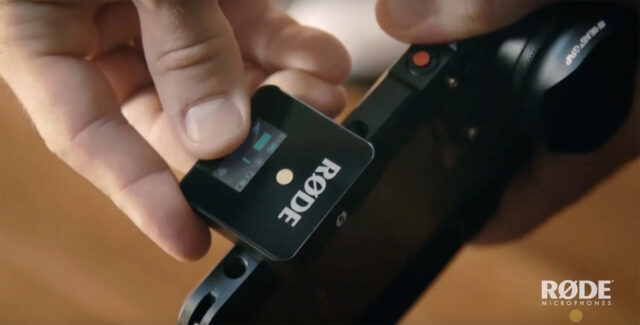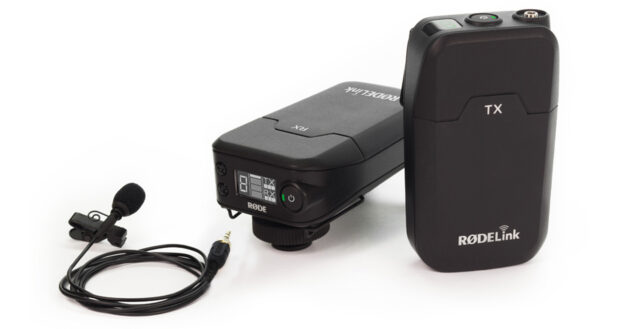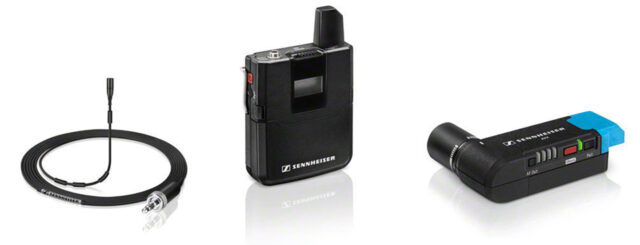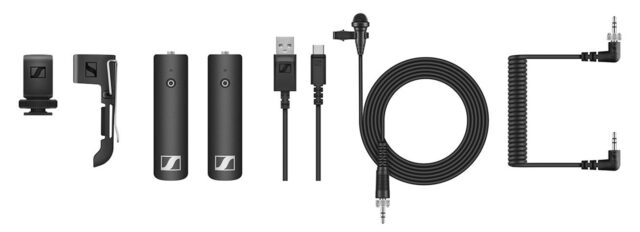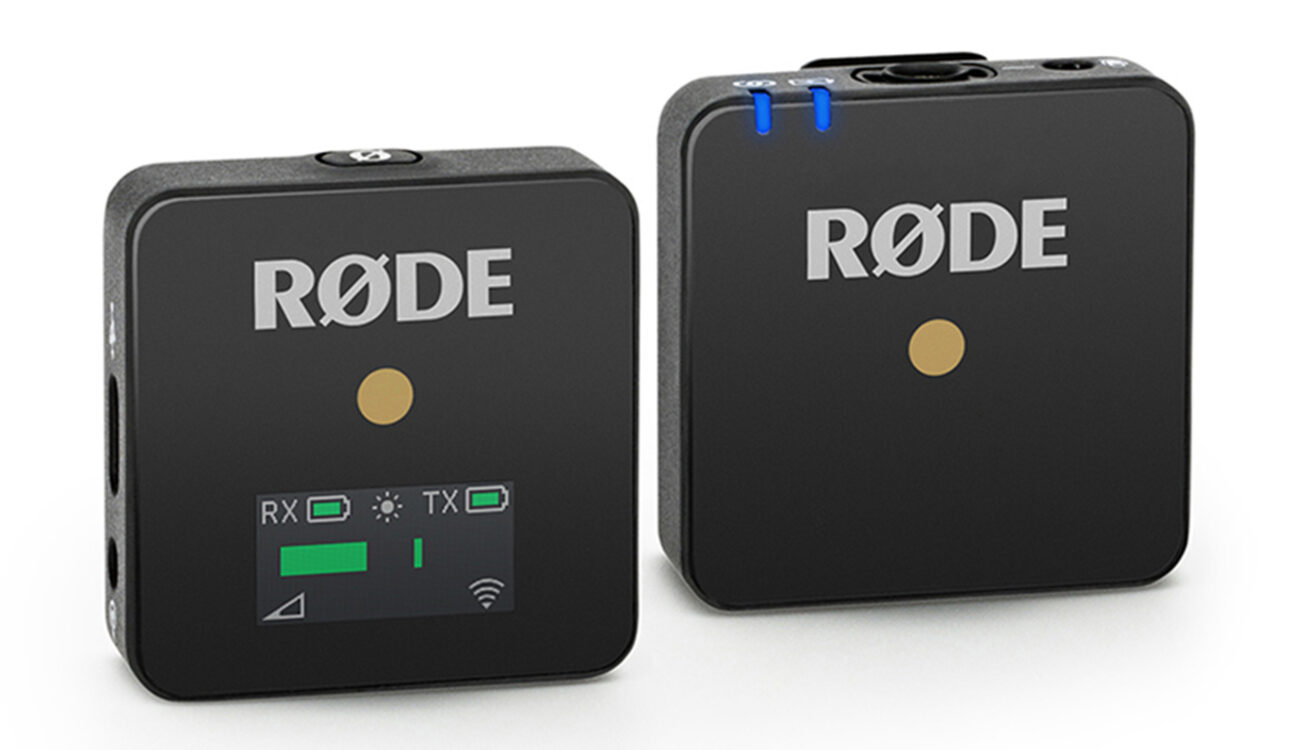
RØDE continues to push the boundaries of audio solutions for real-world filmmakers. Their products are generally very affordable, yet feature-rich and versatile. The new RØDE Wireless Go microphone system is no exception: two tiny boxes, that’s all you need to handle high-quality, single-channel wireless audio on set. 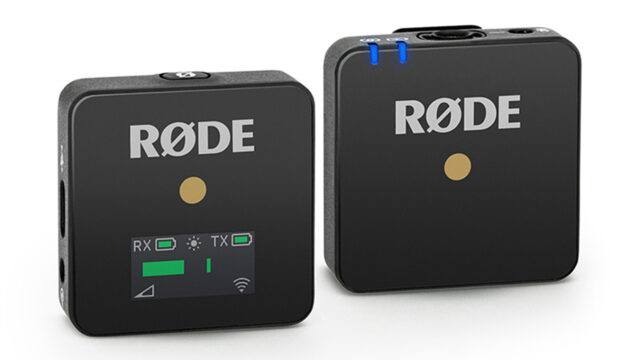
The TX (transmitter) unit of the RØDE Wireless Go system measures just 44mm x 45.3mm x 18.5mm in size and is weighing a mere 31g. And, since we’re talking about a real two-piece setup here, an omnidirectional condenser microphone is built right into the unit. No need for an outboard lav mic. That’s handy but you’ll end up with that box attached to your talent’s shirt. So thankfully an additional 3.5mm TRS socket allows for an outboard lav of choice.
The RØDE Wireless Go units both feature built-in batteries which will last for about 7 hours of continuous use. Recharge them during lunch break via USB-C and you’re good to go for a very long shooting day.
RØDE Wireless Go
If you want to go the minimalistic route, the TX unit features a built-in clip for attaching it to a talents shirt or jacket. As mentioned before –although the unit itself is tiny– I find it a bit awkward to attach the whole thing to a talent. It just doesn’t look right (for me at least).
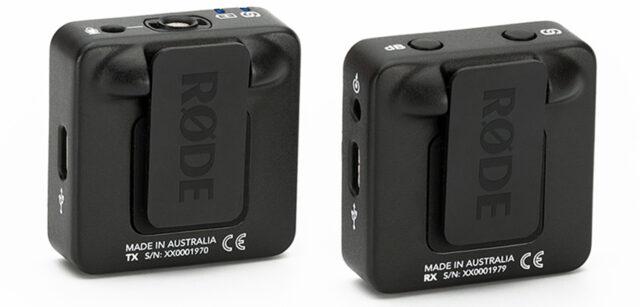 Even the RX unit sports the very same clip so you could attach the receiver to your shirt or wherever if you’re shooting with you cage-less phone for example. Another neat trick: the same clip acts as a cold shoe, too! The TRS output socket can be configured to lower the audio signal by -0dB, -6dB or -12dB to match your cameras or recorders input.
Even the RX unit sports the very same clip so you could attach the receiver to your shirt or wherever if you’re shooting with you cage-less phone for example. Another neat trick: the same clip acts as a cold shoe, too! The TRS output socket can be configured to lower the audio signal by -0dB, -6dB or -12dB to match your cameras or recorders input.
On the technical side of things, the RØDE Wireless Go operates with RØDEs series III 2.4GHz digital wireless transmission. The audio stream is secured by 128-bit encryption. The company claims that this technology provides you with
crystal clear audio under any conditions, even in locations with dense Wi-Fi and Bluetooth activity like shopping malls, conventions, hotels etc.
We are looking forward to testing this out because we have had troubles using the RØDElink Wireless Filmmaker Kit in spaces congested with wireless signals before … namely last year’s NAB.
The range is specified with 70m (line-of-sight) but the system will of course work more reliable at shorter ranges. Up to 8 systems (TX/RX) can be deployed in a single location without any interference. That’s not nothing but it isn’t that much either. This system might not be the best solution for crowded press conferences. Traditional systems still use analog transmission with different channels and radio bands.
These newer generation systems are based on digital transmission and are much easier to handle as they operate worldwide without restrictions but are simply less reliable under certain conditions. And, since the signal needs to be converted from analog to digital (TX) and back to analog again (RX) these systems suffer from a certain amount of latency which renders them problematic (unusable sometimes) when paired with other analog sources.
The Competition
There are 3 main competitors to this RØDE Wireless Go system, two by Sennheiser and one by RØDE (which makes it a bit of a legacy version).
The RØDElink system is pretty bulky in comparison to the new offering by the same company. The RX unit measures 111mm X 65mm X 52mm and it weights 190g. Thats twice the size and seven times the weight!
It also uses series II (rather than series III) 2.4GHz digital transmission with 128-bit encryption.
Sennheiser offers two different series of digital wireless audio systems: The AVX system and the newer XS series. I personally own a AVX kit with the MKE2 lav mic (which is better than the ME2 version) and I’m very happy with it. It certainly suffers from latency but if you use the AVX for single-channel audio only, it’s fine. As opposed to the RØDElink system it also uses adaptive frequency switching, which means that it works much more reliably in areas with a lot of wireless signals – in fact, it has become our main audio unit used on all our trade show videos, just like our upcoming NAB coverage from Las Vegas!
I like the AVX system for its neat XLR receiver unit and the overall built quality and performance. It’s certainly more expensive than the RØDE Wireless Go though, especially if you choose the MKE2 lav instead of the ME2 version.
The third contender would be the new Sennheiser XS wireless system.
This system is pretty versatile as you can choose between two TX units, one with a 3.5mm plug (lav mic) and one with an XLR socket (full-size hand mic). The same goes for the AVX system by the way, Sennheiser has a dedicated AVX hand mic on offer. And last but not least, the RØDElink also offers an XLR TX unit.
Conclusion
I think it’s safe to say that the RØDE Wireless Go system is inheriting the RØDElink, which may be retiring soon. The Sennheiser offerings are decent, yet more expensive. We still have to wait and see how the RØDE performs in real life (especially audio quality and latency). Regarding the competitive price, this new system might draw a lot of customers towards RØDE if the system performs as advertised.
Link: RØDE
What do you think? Are you in the market for a new wireless audio system? Share your thoughts in the comments below!
